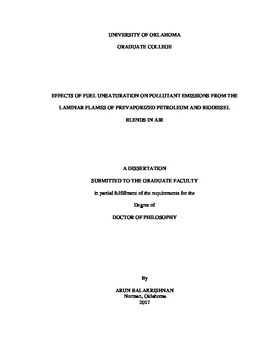| dc.description.abstract | Biodiesels, considered as alternative fuels to petroleum diesel, are defined as fatty acid methyl or ethyl esters derived from triglycerides of vegetable oils or animal fats. The utilization of biodiesels reduces greenhouse gas emissions, assists in sustainable energy development, and enhances energy independence due to the renewable and biodegradable nature of these fuels. Besides being close to environmentally carbon-neutral, biodiesels have properties similar to those of petroleum fuels with comparable energy content and can be blended with petroleum fuels and used in existing engines without major modifications. Furthermore, they contain fuel-bound oxygen while being free of aromatic content; therefore, blends of biodiesels and petroleum fuels present the capability of reducing soot emissions from engines. Blending of biodiesels with petroleum fuels is considered feasible in the near term due to limited current availability of the commercial biodiesels and the lack of experience on the long term effects of storage, handling, transportation and combustion of these biodiesels and blends on the engines and the environment. Several studies in engine literature have revealed that the use of biodiesels and their blends in a compression ignition engine resulted in an appreciable reduction in the emissions of particulate matter (PM), unburnt hydrocarbons (UHC) and CO, compared to the use of diesel fuel. However, in case of nitric oxides (NOx) emissions, the results are variable and case dependent. The average effect of biodiesel on NOx emission was seen to be small, but with a high variance, which resulted in difficulty in discerning a clear pattern. Nitric oxides are categorized as one of the key pollutants in engine emissions that can affect human respiratory system and vegetation. Therefore, it is crucial to understand the effect of various fuel and engine operating parameters on biodiesel NOx emissions to develop enhanced mitigation and abatement techniques for the widespread use of biodiesels in transportation. In engine literature, fuel unsaturation has been attributed to the observed change in NOx emissions with the use of biodiesels in compression ignition engines. Several results indicated the existence of a strong relationship between NOx emissions and iodine number, used as a measure of the fuel unsaturation of vegetable oils and fatty acid methyl esters. However, relevance of iodine number as a measure of total unsaturation of petroleum fuels like diesel, Jet A and their blends with biodiesels is debatable due to the significant differences in the reactivity of iodine with petroleum fuels. Bromine number, used as a measure of aliphatic unsaturation in petrofuel samples, does not account for the aromatic unsaturation from petroleum fuels. Hence, a common parameter that is relevant for both biodiesels and petroleum fuels needs to be identified to quantify the fuel unsaturation. A parameter, termed “Degree of Unsaturation (DOU),” which accounts for the total unsaturation of the fuel from all sources such as double and triple bonds, aromatics and other ring structures irrespective of the families of the fuels (alkanes, alkenes, alkynes, aromatics, ether or ester) that has been used in organic chemistry literature is proposed in this work and identified as a potential indicator of NOx emissions from biodiesel blends. In this dissertation work, experimental correlations between DOU and the NO emission index on a mass basis (EINO) in laminar flames of neat prevaporized fuels such as methyl oleate (MO), soy methyl ester (SME), canola methyl ester (CME), rapeseed methyl ester (RME), palm methyl ester (PME), heptane, toluene, diesel, JetA and petroleum/biodiesel blends at various equivalence ratios (Ф = 0.9, 1.0, 1.2 and 1.5) are developed. The NO emission index of flames of biodiesel/petroleum blends was found to increase with DOU, but with varying trends depending on their families of origin. The effects of DOU on EINO were significantly influenced by the equivalence ratio, with the maximum influence at an equivalence ratio of 1.2. At the equivalence ratio (Ф) of 1.2, EINO increased from 2.4 g/kg at a DOU value of 1.7 to 4.4 g/kg at a DOU of 3.0 among biodiesels and their blends with petroleum fuel; toluene flame (100% aromatic content with a DOU of 4) produced an EINO of 6.94 g/kg. It is found that both NO and CO emission indices from the tested flames are influenced by two major parameters - equivalence ratio and total fuel unsaturation. Further, the presence of fuel aromatic content and the family of fuel were observed to significantly influence NOx formation particularly near stoichiometric equivalence ratios. Based on both global and inflame emission results along with the numerical analysis of tested flames, it is concluded that fuel unsaturation, fuel aromatic content, equivalence ratio and family of the respective fuel, together influence the NOx emissions in flames. The net effects of these parameters at a given condition establish the amount of EINO produced from the corresponding flames due to the fuel chemistry effect alone. Hence, DOU provides a common platform to compare and quantify the effects of fuel unsaturation across different fuel families and can be employed as an indicator of NOx emissions. DOU can be evaluated based on the average molecular formula of the fuel alone without involving complex and expensive experimental procedures such as those involved in the measurement of iodine number. The propensity of a biofuel blend for NOx emissions during combustion can be quickly ascertained with the successful development of Degree of Unsaturation (DOU) parameter, thus, providing a valuable tool for fuel developers. | en_US |
